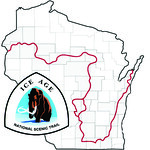A kettle is a depression in the land and is formed when a block of ice breaks away from a receding glacier.
- The ice then gets buried by glacial outwash.
- When the ice blocks eventually melt, kettle holes are left behind.
In most cases, kettle holes eventually fill with water, sediment, or vegetation.
Most kettle holes are less than a mile in diameter, although some in the Midwest exceed 6 miles. Most are also less than 30 feet deep.
A peat bog is an area of wet spongy ground of decomposing vegetation. It has poorer drainage than a swamp. It is formed where water on the surface is acidic and low in nutrients. Flooded hollows and basins provide ideal growing conditions for reeds and sedges. When the vegetation dies, the water in the hollows prevents oxygen from reaching the dead plants. Organisms that decompose plants can’t survive without oxygen so the plants do not completely rot away. Partly rotted plants gradually build up to form peat.
The gradual accumulation of plant material in a bog functions as a carbon sink. The distinctive group of plant and animal species are very important for biodiversity. A typical peat bog contains about 95% water and 5% organic matter.
According to the authors of Geology of the Ice Age National Scenic Trail, “Peat will eventually take over the rest of the open water and all of Firth Lake will become a peat bog with a small stream flowing through it.”
 IATCC is the cache designation to highlight a series of EarthCaches along the Ice Age National Scenic Trail grouped into a special category called "ColdCache."
IATCC is the cache designation to highlight a series of EarthCaches along the Ice Age National Scenic Trail grouped into a special category called "ColdCache."
The Ice Age Trail is one of eleven National Scenic Trails designated by the National Park Service. This unique trail is entirely within the state of Wisconsin and follows along the terminal moraine of the most recent glacier which retreated about 10,000 years ago.
This project is supported by the Ice Age Trail Alliance (IATA). The goal is to bring more visitors to the trail and promote public awareness, appreciation, and understanding of Wisconsin’s glacial landscape.
The IATA has created an awards program to encourage visits to the trail and ColdCache sites. This awards program is separate from, and in addition to, any other Geo- or EarthCache awards program.
A current list of approved ColdCache sites can be found on the “IATCC Bookmark List”. More information on the Ice Age Trail Atlas, the Companion Guide, the ColdCache Project and Awards Program can be found on the “ColdCache Webpage”
The Geocache Notification Form has been submitted to Mike Rivers of the Wisconsin DNR. Geocaches placed on Wisconsin Department of Natural Resource managed lands require permission by means of a notification form. Please print out a paper copy of the notification form, fill in all required information, then submit it to the land manager. The DNR Notification form and land manager information can be obtained at: www.wi-geocaching.com/hiding
Geology of the Ice Age National Scenic Trail; by David M. Mickelson, Louis J. Mahler Jr., and Susan L. Simpson
Wikipedia
Tasks:
- Describe the differences you see on either side and end of the boardwalk
- Compose an alliteration using the words peat and Pete that also describes in which direction you think the bog is moving.
- Estimate the area (in square feet) of the peat bog in it's current state. Make a prediction of the peat bog area in the future (eg: 10, 20, . . . 50 years from now). Show the formula you used.